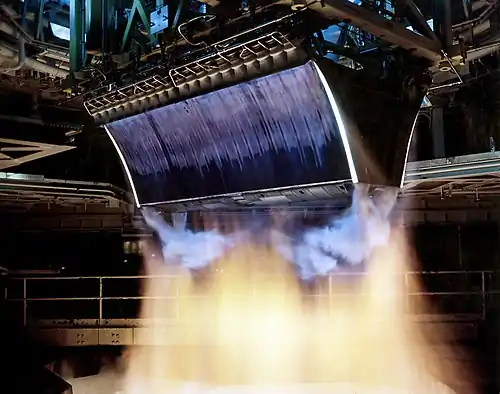Rocketdyne XRS-2200
The Rocketdyne XRS-2200 was an experimental linear aerospike engine developed in the mid-1990s for the Lockheed Martin X-33 program.[1][2][3] The design was based on the J-2S, the upgraded version of the Apollo era J-2 engine developed in the 1960s. The XRS-2200 used the J-2's combustion cycle and propellant choice.[4]
 Rocketdyne XRS-2200 hotfire test | |
| Country of origin | United States |
|---|---|
| Date | 1999 |
| Designer | Rocketdyne |
| Manufacturer | Rocketdyne |
| Application | X-33 |
| Predecessor | J-2S |
| Status | Experimental |
| Liquid-fuel engine | |
| Propellant | LOX / LH2 |
| Cycle | Gas Generator |
| Configuration | |
| Nozzle ratio | 58:1 |
| Performance | |
| Thrust, vacuum | 1,184 kN (266,000 lbf) |
| Thrust, sea-level | 909 kN (204,000 lbf) |
| Chamber pressure | 58 bar (840 psi) |
| Specific impulse, vacuum | 439 seconds (4.31 km/s) |
| Specific impulse, sea-level | 339 seconds (3.32 km/s) |
| Dimensions | |
| Length | 2.01 m (6 ft 7 in) |
Rocketdyne intended to develop the subscale XRS-2200 into the RS-2200 for use on the VentureStar. While the X-33 program was cancelled, two XRS-2200 engines were produced and tested.[5]
References
- "Boeing Rocketdyne XRS-2200 Linear Aerospike". engineering.purdue.edu. Retrieved 2019-08-26.
- "XRS-2200 Link". www.hq.nasa.gov. Washington D.C., U.S.: NASA Headquarters. Retrieved 2019-09-29.
- Rowbotham, Maureen (1999). "XRS-2200 linear aerospike engine - Use of Pro/ENGINEER for determining mass properties". 35th Joint Propulsion Conference and Exhibit. U.S.: American Institute of Aeronautics and Astronautics. doi:10.2514/6.1999-2334. Retrieved 2019-09-29.
- "XRS-2200". www.astronautix.com. Encyclopedia Astronautica. Archived from the original on December 28, 2016. Retrieved 2019-08-26.
- D'Agostino, M.G. (January 2001). "X-33 XRS-2200 Linear Aerospike Engine Sea Level Plume Radiation" (PDF). NASA Technical Reports Server.
This article is issued from Wikipedia. The text is licensed under Creative Commons - Attribution - Sharealike. Additional terms may apply for the media files.